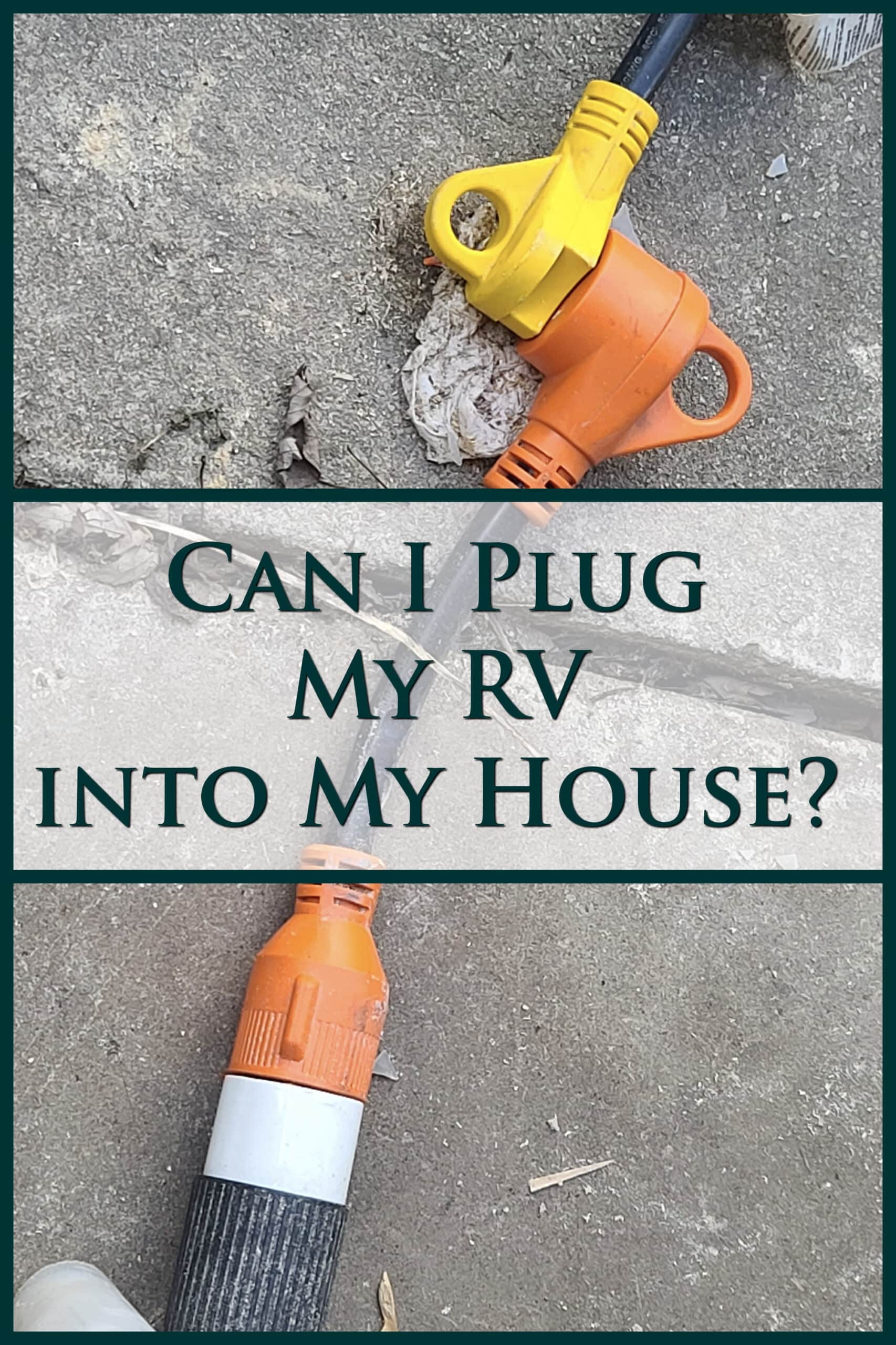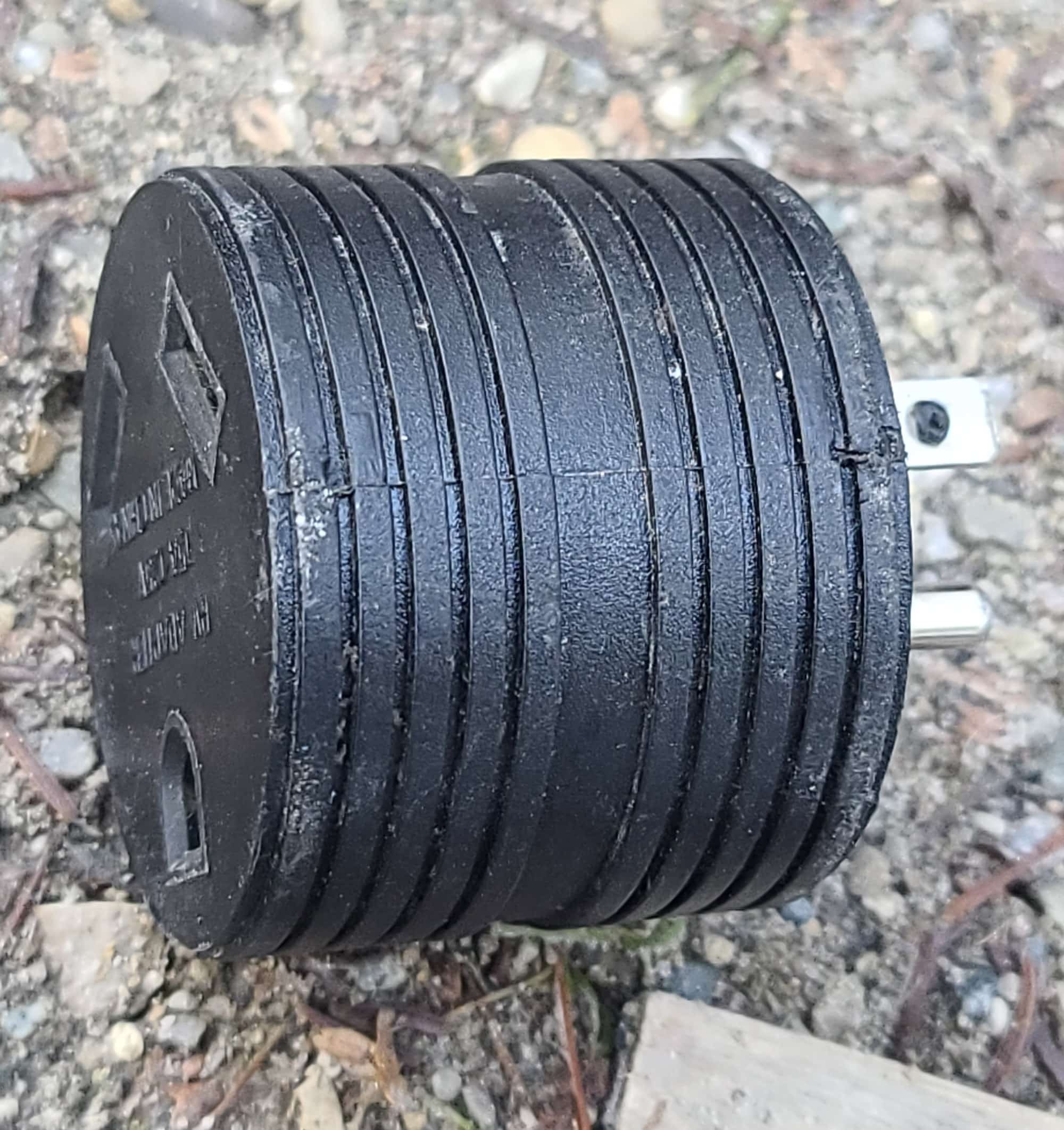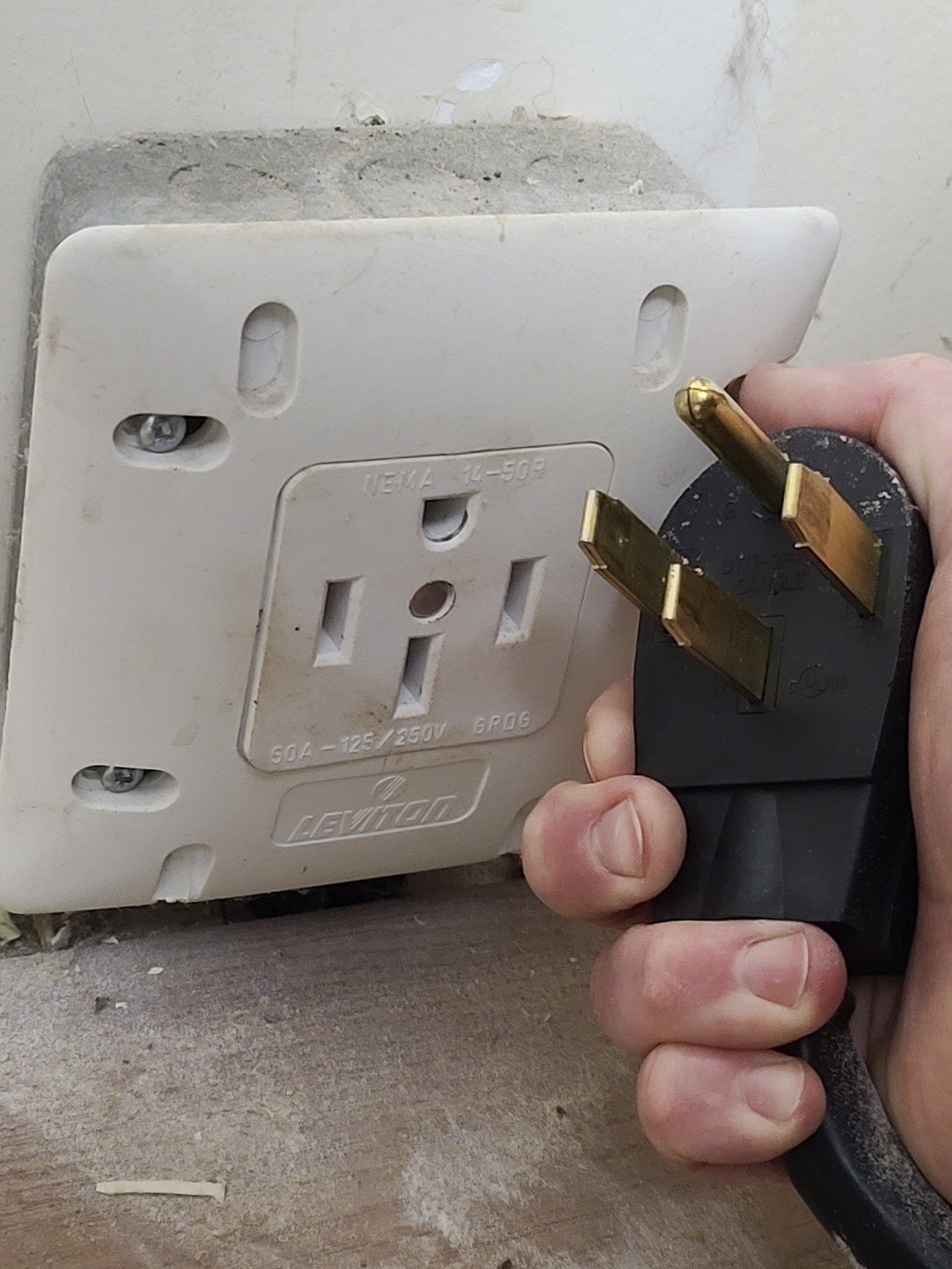Are you wondering, “Can I Plug My Travel Trailer Into My House?” The answer is yes, and TRAVELS.EDU.VN is here to guide you through the process safely and efficiently. Connecting your RV to your home’s power can be a convenient way to maintain batteries, load/unload gear, or even power some appliances. We’ll explore various power options, necessary adapters, safety considerations, and even offer insights on upgrading your home’s electrical setup to accommodate your RV. Whether you’re prepping for a trip to Napa Valley or simply need to keep your RV in top condition, TRAVELS.EDU.VN ensures you’re well-informed and ready to roll.
1. Understanding the Basics of RV and Home Electrical Systems
Before diving into the specifics of connecting your travel trailer to your house, let’s understand the fundamentals. Both your RV and your home use similar electrical systems, featuring hot, neutral, and ground wires.
- Hot and Neutral Wires: These are the main power lines, delivering the electricity needed to run your appliances and devices.
- Ground Wire: This crucial safety component prevents electrical shocks by providing a path for stray current in case of a fault.
Connecting your RV to your home’s electrical system is like adding another room to your house. However, it’s essential to consider that your RV is exposed to the elements, so outdoor-grade components are a must.
 A close-up showing the hot, neutral and ground wires of an RV power cable, illustrating the essential components of both home and RV electrical systems
A close-up showing the hot, neutral and ground wires of an RV power cable, illustrating the essential components of both home and RV electrical systems
2. Key Assumptions About Your Home and RV Electrical Service
This guide assumes your house has a 120/240V electrical service, which is standard in North America. Your RV is presumed to have a 15A, 20A, or 30A service. Larger RVs like Class A motorhomes might use a 50A service. It’s important to note that 110V, 115V, 120V, and 125V services are essentially the same and compatible. Your RV and electrical devices are designed to work within this range. Also, your RV’s 12V appliances (water pump, lights) run through a power converter that charges your RV batteries when plugged into shore power.
3. Permits and Inspections: What You Need to Know
If you’re planning to install a dedicated outlet for your RV, it’s crucial to check local regulations. In most cases, you can do the work yourself but might need to submit a plan, obtain a permit, and pass an inspection. Permanent installations, like new outlets, typically require permits. Temporary setups, such as using extension cords, usually don’t. However, confirming local requirements is your responsibility to ensure compliance.
4. Exploring Your Power Options for RV Connection
Understanding the available power options is crucial for effectively powering your RV from home.
4.1. 15A Power Supply: The Standard Household Outlet
A 15-amp power supply, often found in standard household outlets, provides 15A x 120V = 1800 watts. This is enough for individual high-power devices but might struggle with starting your RV’s air conditioner.
- Pros: Readily available in most homes.
- Cons: Insufficient for running multiple high-power appliances simultaneously.
- Best For: Keeping batteries charged, turning on lights for loading/unloading.
4.2. 20A Power Supply: A Slight Upgrade
A 20-amp power supply delivers 20A x 120V = 2400 watts, offering 33% more power than a standard 15A outlet. It looks similar to a 15A outlet but accepts a sideways pin.
- Pros: Can handle an air conditioner and fridge simultaneously.
- Cons: Difficult to find power cords rated for 20 amps.
- Best For: Running essential appliances, but be cautious about overloading.
4.3. 30A Power Supply: The Campground Standard
A 30-amp power supply provides 30A x 120V = 3600 watts, doubling the power of a standard 15A outlet. This is the standard electrical hookup in most campgrounds and RV parks.
- Pros: Sufficient for running multiple high-power devices, including air conditioning, fridge, and a coffee maker. Uses thicker wiring to prevent voltage drop.
- Cons: Requires a dedicated 30A outlet.
- Best For: Running most RV appliances without worrying about tripping breakers.
4.4. 50A Power Supply: For the Big Rigs
A 50-amp power supply consists of two 50-amp lines, 180 degrees out of phase, delivering 50A x 240V = 12000 watts. This allows the use of both 120V and 240V appliances.
- Pros: Handles electric stoves, clothes dryers, and water heaters. Essential for large RVs like Class A motorhomes.
- Cons: Requires a specialized 50A outlet.
- Best For: Powering all appliances in large RVs, including high-demand 240V devices.
5. The Adapter Advantage: Connecting Any RV to Any Outlet
Adapters are available for nearly every conceivable combination of plugs and outlets. It is important to ensure you are using a safe system. Even small pop-up campers with a 15A service can safely plug into a 30A or 50A service outlet using an adapter because your RV has its own fuses and safety systems. Drawing less than the maximum power from an outlet is safe.
 Image of a 30 amp to 15 amp adapter, allowing RV owners to connect to standard household outlets
Image of a 30 amp to 15 amp adapter, allowing RV owners to connect to standard household outlets
5.1. Adapter Possibilities: A Quick Reference Table
| Plug Side (Male) | Socket/Outlet Side (Female) | Adapter Name |
|---|---|---|
| 15A | 30A | 15A Male to 30A Female Adapter |
| 30A | 50A | 30A Male to 50A Female Adapter |
| 15A | 50A | 15A Male to 50A Female Adapter |
| 50A | 30A | 50A Male to 30A Female Adapter |
| 50A | 15A | 50A Male to 15A Female Adapter |
| 30A | 15A | 30A Male to 15A Female Adapter |
Adapters are also available for generator hookups. You can connect a 3-prong generator to your 30A RV plug or a 4-prong generator to your 30A or 50A RV plug. Carrying a 15A adapter and a long 15A outdoor extension cord can be beneficial for campsites with distant power posts.
6. Unsafe Adapter Conditions: What to Avoid
Using a lesser-grade cable between the outlet and RV can create unsafe conditions. For example, using an adapter to plug a 15A extension cord into a 30A outlet, then another adapter to connect to your RV, can be dangerous. The thin cable is not designed to carry that much current. A fuse or circuit breaker won’t blow because both the house and RV are rated for 30 amps, but the cable could overheat and cause a fire. If you need adapters at both ends of a cable, reassess your setup. It’s better to use the correct cable for the job.
7. Leveraging Existing Outlets: Making the Most of What You Have
Before investing in new outlets, assess what’s already available. Many homes have 15A outdoor outlets, though they may not be conveniently located. Extension cords can solve this issue. Using extension cords with larger-than-needed wires is a good idea to combat voltage drops and overheating.
7.1. Creative Power Solutions in Unexpected Places
Garages often have high-power outlets for welders or air compressors. You can use these outlets for your RV, even if it requires running a long cable. Another option is the electric stove outlet, which is typically a 50A, 240V connection.
 Image of a 50 amp RV plug next to an electric stove outlet, highlighting the identical connection types
Image of a 50 amp RV plug next to an electric stove outlet, highlighting the identical connection types
Use an adapter to convert the 50A plug to a 30A outlet, then connect your long 30A extension cord to your RV. For temporary power, running the extension cord through a window and sealing the gap with a towel can work. While a dryer outlet might seem like a good option, it may not provide the necessary 120V tap.
8. Installing a New Outlet: Considerations for a Permanent Solution
When installing a new outlet, local codes and laws will dictate the details. Use outdoor-grade components to ensure a safe and reliable connection. Check your circuit breaker panel for available slots. 15A, 20A, and 30A connections need one slot, while 50A connections require two adjacent slots. If your panel is full, tandem breakers can free up space.
8.1. Future-Proofing Your Electrical Setup
Consider future needs when installing a new outlet. Even if 15A service is sufficient now, upgrading to a 30A outlet is a wise investment. If you plan to get an electric car, installing upgraded wiring now can be leveraged for charging in the future.
9. Safety First: Inverters, Generators, and Back-Feeding
Inverters and generators can potentially back-feed into your RV plug, especially in DIY setups. Do not run an inverter or generator while your RV is plugged into your house. Use a multimeter to test for voltage at the disconnected RV plug to ensure safety.
10. Weatherproofing Your Outdoor Connections
Prepare for all types of weather: extreme heat, rain, ice, and snow. Choose locations that minimize exposure to water pooling or icy conditions. Shelter connections under the RV to protect them from rain and snow. Keep cords out of direct sunlight to prevent insulation degradation. Consider covering cables with split loom for added protection.
11. Plan Your Napa Valley Getaway with TRAVELS.EDU.VN
Now that you know how to safely and efficiently connect your travel trailer to your house, you’re one step closer to the perfect Napa Valley getaway. Napa Valley is a premier destination known for its picturesque vineyards, world-class wineries, and exceptional culinary experiences. The region offers a diverse range of activities that cater to various interests and preferences. Whether you’re looking to explore the art of winemaking, indulge in gourmet meals, or simply relax amidst stunning natural landscapes, Napa Valley promises an unforgettable experience.
11.1 Must-Visit Destinations in Napa Valley
- World-Class Wineries: Napa Valley is home to over 400 wineries, each offering unique tasting experiences and tours. Iconic wineries like Robert Mondavi Winery, Chateau Montelena, and Beringer Vineyards are a must-visit for any wine enthusiast.
- Gourmet Dining: Napa Valley’s culinary scene is as impressive as its wines. Michelin-starred restaurants like The French Laundry and Restaurant at Meadowood offer exquisite dining experiences. Numerous farm-to-table restaurants also provide fresh, seasonal dishes that perfectly complement the local wines.
- Picturesque Landscapes: Beyond wine and food, Napa Valley boasts stunning landscapes. Scenic drives along the Silverado Trail and the Napa River offer breathtaking views. The region’s rolling hills and lush vineyards provide the perfect backdrop for leisurely walks, picnics, and hot air balloon rides.
11.2 Activities and Experiences
- Wine Tasting Tours: Explore Napa Valley’s wineries with guided tours that provide insights into the winemaking process. These tours often include tastings of various wines, allowing you to savor the region’s finest offerings.
- Culinary Classes: Learn to prepare gourmet dishes with local chefs in hands-on cooking classes. These classes often focus on using fresh, seasonal ingredients from Napa Valley’s farms.
- Hot Air Balloon Rides: Experience Napa Valley from a unique perspective with a hot air balloon ride. These rides offer stunning aerial views of the vineyards and surrounding landscapes.
11.3 Accommodation Options
- Luxury Hotels and Resorts: Napa Valley offers a range of luxury hotels and resorts, such as Meadowood Napa Valley and Auberge du Soleil. These properties provide exceptional amenities, spa services, and fine dining options.
- Boutique Inns and Bed & Breakfasts: For a more intimate experience, consider staying at one of Napa Valley’s charming boutique inns or bed & breakfasts. These establishments offer personalized service and comfortable accommodations.
- Vacation Rentals: Renting a private home or villa can be an excellent option for families or groups. These rentals provide more space and privacy, often with amenities like private pools and fully equipped kitchens.
11.4 Preparing for Your Trip
- Best Time to Visit: The best time to visit Napa Valley is during the spring (March-May) or fall (September-November) when the weather is mild, and the vineyards are at their most beautiful.
- Transportation: Renting a car is the most convenient way to explore Napa Valley. Alternatively, consider hiring a private driver or joining a guided tour.
- Reservations: Making reservations for wine tastings, dining, and accommodations is highly recommended, especially during peak season.
12. Let TRAVELS.EDU.VN Handle Your Napa Valley Travel Planning
Planning a trip to Napa Valley can be overwhelming. Between selecting the best wineries, restaurants, and accommodations, the details can quickly add up. That’s where TRAVELS.EDU.VN comes in. We specialize in creating customized Napa Valley travel experiences that cater to your unique preferences and budget.
12.1 Benefits of Booking with TRAVELS.EDU.VN
- Customized Itineraries: We create personalized itineraries that focus on your interests, whether it’s wine tasting, gourmet dining, or exploring Napa Valley’s scenic beauty.
- Exclusive Access: Through our extensive network, we provide access to exclusive wine tastings, private tours, and special events.
- Stress-Free Planning: From booking accommodations to arranging transportation, we handle all the details, allowing you to relax and enjoy your trip.
- Expert Advice: Our team of travel experts offers valuable insights and recommendations, ensuring you make the most of your Napa Valley experience.
12.2 Why Choose TRAVELS.EDU.VN?
- Local Knowledge: We have in-depth knowledge of Napa Valley, allowing us to curate authentic and memorable experiences.
- Personalized Service: We take the time to understand your preferences and create a trip that exceeds your expectations.
- Value for Money: We offer competitive pricing and work to maximize your budget, ensuring you receive the best value for your travel investment.
- 24/7 Support: Our customer service team is available 24/7 to assist you with any questions or concerns before, during, and after your trip.
12.3 Napa Valley Package Options
| Package Name | Duration | Key Features | Price (USD) |
|---|---|---|---|
| Wine Lover’s Escape | 3 Days | Guided wine tasting tours at renowned wineries, gourmet dining experiences, and luxury hotel accommodations. | $1,500 |
| Culinary Adventure | 4 Days | Hands-on cooking classes with local chefs, farm-to-table dining experiences, visits to artisanal food producers, and boutique inn accommodations. | $1,800 |
| Scenic Getaway | 5 Days | Hot air balloon ride over Napa Valley, scenic drives along the Silverado Trail, visits to state parks, guided hiking tours, and private villa accommodations. | $2,200 |
| Custom Package | Varies | Tailored itinerary based on your preferences, including wine tastings, dining, activities, and accommodations. Contact us for a personalized quote. | Varies |
Note: Prices are per person and may vary based on availability and specific inclusions.
12.4 Ready to Book Your Napa Valley Adventure?
Don’t let the stress of planning overshadow the excitement of your trip. Contact TRAVELS.EDU.VN today and let our expert team create the perfect Napa Valley experience for you.
- Address: 123 Main St, Napa, CA 94559, United States
- WhatsApp: +1 (707) 257-5400
- Website: TRAVELS.EDU.VN
Call to Action: Contact us now to receive a free consultation and personalized itinerary for your dream Napa Valley getaway. Let TRAVELS.EDU.VN turn your travel aspirations into reality. Book your Napa Valley experience today and discover the magic of California’s wine country. Let TRAVELS.EDU.VN take care of all the details so you can focus on making memories.
13. Final Thoughts on Safely Powering Your RV at Home
Using any outlets that already exist on your home is the best bet, even if it’s not ideal. Purchase heavy-duty extension cords to carry this power to your RV. Keep cords and connections safe and out of the elements as much as possible. If you’re going to install a new outlet for your RV, make sure it’s future-proof by getting the largest capacity outlet that you might need.
With the right knowledge and preparation, you can safely and efficiently connect your travel trailer to your house. Whether you’re planning a weekend getaway to Napa Valley or simply need to maintain your RV at home, TRAVELS.EDU.VN is here to help.
14. Frequently Asked Questions (FAQs)
Q1: Is it safe to plug my RV into a standard household outlet?
Yes, it is generally safe, but you will be limited by the 15A power supply. Avoid running multiple high-power appliances simultaneously to prevent tripping the circuit breaker.
Q2: What type of adapter do I need to plug my 30A RV into a 15A outlet?
You need a 30A male to 15A female adapter.
Q3: Can I use a regular extension cord to power my RV?
It is recommended to use heavy-duty, outdoor-rated extension cords with a sufficient gauge (AWG) to handle the amperage. Avoid using thin, household extension cords.
Q4: How do I protect my RV power connections from the weather?
Shelter connections under the RV or use weatherproof covers. Keep cords out of direct sunlight to prevent insulation degradation.
Q5: What should I do if my circuit breaker keeps tripping when my RV is plugged in?
Reduce the number of appliances running simultaneously. If the problem persists, consider upgrading to a higher amperage outlet or consult with an electrician.
Q6: Can I run my RV air conditioner on a 15A household outlet?
It depends on the air conditioner’s power consumption. Some smaller units may run, but it’s best to avoid using other high-power appliances simultaneously.
Q7: What is back-feeding, and how can I prevent it?
Back-feeding occurs when an inverter or generator sends power back into the electrical grid. To prevent it, do not run an inverter or generator while your RV is plugged into your house.
Q8: Do I need a permit to install a new RV outlet at my house?
Yes, permanent installations like new outlets typically require permits. Check with your local government for specific regulations.
Q9: What is the difference between a 30A and 50A RV service?
A 30A service provides 3600 watts, while a 50A service provides 12000 watts. A 50A service also uses two 50-amp lines, allowing for both 120V and 240V appliances.
Q10: How can TRAVELS.EDU.VN help me plan my Napa Valley trip?
travels.edu.vn offers customized itineraries, exclusive access to wineries and events, stress-free planning, and expert advice to create the perfect Napa Valley experience. We can be contacted through various communication channel such as Whatsapp, phone and email.

